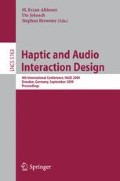Abstract
A very common task in medical applications and motor-skill training is to trace a path. However, when designing a haptically guided interface, designers need to consider the choice of several parameters in the design. These include the real-time function for bringing back the user to the right path, the effect of the path’s curvature on tracing, and the amount of haptic force needed for guiding the user appropriately. In this paper, we describe the results of an experiment that was designed to assess the effect of several design factors that can influence the performance of path tracing tasks. Our results show that the shape of the path has an effect on the amount of deviation from a path. Additionally, we found that a high amount of stiffness is preferred over low stiffness. Finally, the type of force profile that haptically guides the user, particularly the slope of the function, is also an important factor in path tracing tasks. We discuss our results with implications for designs of systems necessitating haptic force feedback in constrained path tracing tasks.
Access this chapter
Tax calculation will be finalised at checkout
Purchases are for personal use only
Preview
Unable to display preview. Download preview PDF.
References
Avizzano, C.A., Solis, J., Frisoli, A., Bergamasco, M.: Motor Learning Skill Experiments using Haptic Interface Capabilities. In: Proc. of ROMAN, pp. 198–203 (2002)
Crossan, A., Brewster, S.: Multimodal Trajectory Playback for Teaching Shape Information and Trajectories to Visually Impaired Computer Users. ACM Transactions on Accessible Computing 1(2) (2008)
Feygin, D., Keehnder, M., Tendick, F.: Haptic guidance: Experimental evaluation of a haptic training method for a perceptual motor skill. In: Proc. of HAPTICS, pp. 40–47 (2002)
Henmi, K., Yoshikawa, T.: Virtual lesson and its application to virtual calligraphy system. In: Proc. of ICRA, pp. 1275–1280 (1998)
Kim, Y.K., Yang, X.: Real-Time Performance Analysis of Hand Writing Rehabilitation Exercise in Haptic Virtual Reality. In: Proc. of Canadian Conference on Electrical and Computer Engineering, pp. 1357–1360 (2007)
Pastel, R.: Measuring the difficulty of steering through corners. ACM CHI, 1087–1096 (2006)
Plimmer, B., Crossan, A., Brewster, S.A., Blagojevic, R.: Multimodal collaborative handwriting training for visually-impaired people. In: Proc. of CHI, pp. 393–402 (2008)
Portillo-Rodriguez, O., Avizzano, C.A., Chavez-Aguilar, A., Raspolli, M., Marcheschi, S., Bergamasco, M.: Haptic desktop: The virtual assistant designer. In: Proc. of MESA, pp. 1–6 (2006)
Rosenberg, L.B.: Virtual fixtures: Perceptual tools for telerobotic manipulation. In: Proc. of the IEEE Annual Int. Symposium on Virtual Reality, pp. 76–82 (1993)
SensAble Technologies (1993), http://www.sensable.com
Saga, S., Kawakami, N., Tachi, S.: Haptic teaching using opposite force presentation. In: Proc. of the World Haptics, pp. 18–20 (2005)
Teo, C.L., Burdet, E., Lim, H.P.: A robotic teacher of Chinese handwriting. In: Proc. of HAPTICS, pp. 335–341 (2002)
Tavakoli, M., Patel, R.V., Moallem, M.: A haptic interface for computer-integrated endoscopic surgery and training. Virtual Reality 9, 160–176 (2006)
Webster, R., Zimmerman, D., Mohler, B., Melkonian, M., Haluck, R.: A prototype haptic suturing simulator. Medicine Meets Virtual Reality 81, 567–569 (2001)
Williams, R.L., Srivastava, M., Conaster, R.: Implementation and evaluation of a haptic playback system. Haptics-e 3(3), 160–176 (2004)
Yang, X.D., Bischof, W.F., Boulanger, P.: Validating the performance of haptic motor skill learning. In: Proc. of HAPTICS, pp. 129–135 (2008)
Author information
Authors and Affiliations
Editor information
Editors and Affiliations
Rights and permissions
Copyright information
© 2009 Springer-Verlag Berlin Heidelberg
About this paper
Cite this paper
Zarei-nia, K., Yang, XD., Irani, P., Sepehri, N. (2009). Evaluating Factors that Influence Path Tracing with Passive Haptic Guidance. In: Altinsoy, M.E., Jekosch, U., Brewster, S. (eds) Haptic and Audio Interaction Design. HAID 2009. Lecture Notes in Computer Science, vol 5763. Springer, Berlin, Heidelberg. https://doi.org/10.1007/978-3-642-04076-4_3
Download citation
DOI: https://doi.org/10.1007/978-3-642-04076-4_3
Publisher Name: Springer, Berlin, Heidelberg
Print ISBN: 978-3-642-04075-7
Online ISBN: 978-3-642-04076-4
eBook Packages: Computer ScienceComputer Science (R0)

